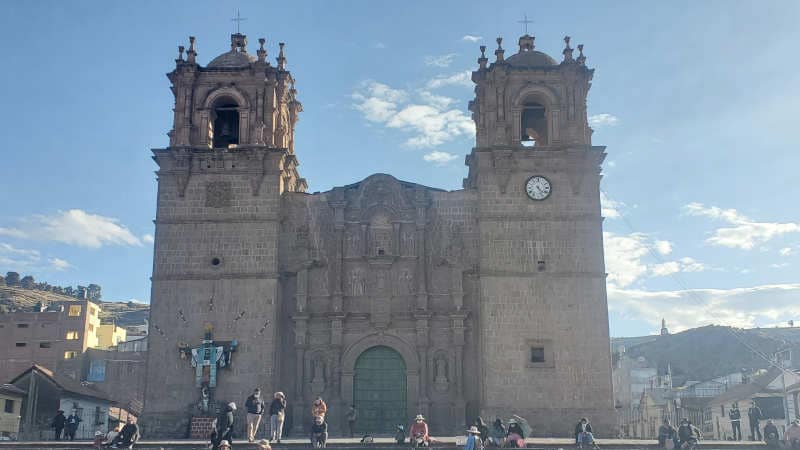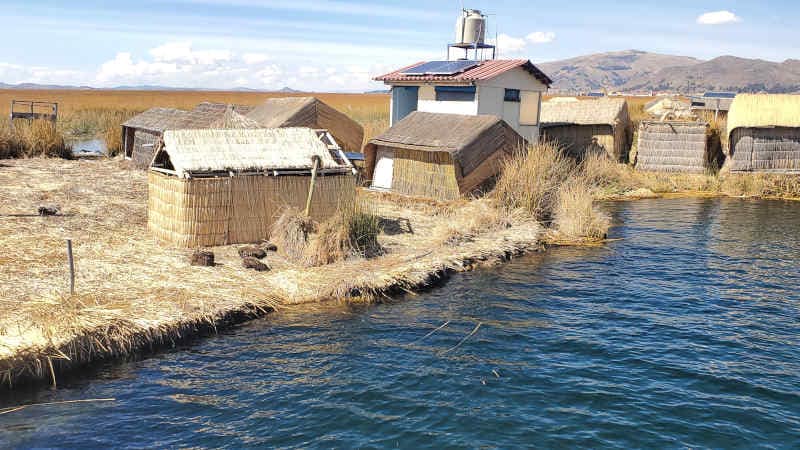The morning after I completed my Colca Canyon trek it was off to Puno. The day started off a little rough as the bus to pick me up was late and I was concerned that it had forgotten me. Then about an hour from Puno the bus had mechanical issues and we lost about 45 minutes as the driver tried to figure out what was wrong. Fortunately for those of us going to Puno, we were close to a small town where we transferred to a van for the remainder of our trip. The roads in Puno are way too narrow for something like a bus. The rest of the passengers would wait in town while the mechanic tried to figure out what was wrong with their bus. Then they had a long drive through a remote part of Peru to get to Cusco.

My afternoon in Puno would be relaxing as I needed a break and the elevation was a little under 13,000 feet. Just going up stairs was enough to get me breathing hard. The next morning I left for a two-day trip on Lake Titicaca, the highest navigable lake in the world! Not too long after boarding the boat we arrived at the Uros Islands. These islands are floating islands created by the Uros people out of totora reed. This reed needs to be replenished frequently to reduce the possibility of fire and to keep the islands stable.

We stopped at one of the islands and got off our boat. One of the passengers immediately lit up a cigarette and quickly was told to put it out. The reed that makes up these islands is like straw but thicker. Fire and straw do not go together. On this island we received a tour and saw a presentation about how the islands are made. On these islands the people speak Aymara but our guide was able to translate. Initially the Uros moved to Lake Titicaca to avoid the Incas who were taking over this part of South America. The islands were a form of defense that could be moved to evade their enemies. The first to move out on the lake lived in boats but then they created these floating islands. Now people live on them so they don’t have to pay taxes.

Once our tour was over we got onto a boat made out of reed and rode it to another island. After purchasing some delicious bread made of quinoa it was back on our tour boat and off to Amantani.


I would be staying on the island of Amantani with a native Quechua family. Upon stepping onto the island we were broken up into small groups and were introduced to our host family. The Amantani people speak Quechua but the younger generation has learned Spanish in school so it was easier to communicate. It was a struggle to walk uphill to our house as we were at just under 13,000 feet of elevation. I had not gotten used to the lack of oxygen yet. At our house we were shown our rooms for the night, we had a freshly cooked lunch (delicious!), and then we gathered at the central square for a short hike.

We would be climbing towards the top of the island to visit one or both of the temples on the island. Once again, climbing was a lot more difficult than I would have thought. It wasn’t steep but the lack of oxygen definitely was felt. After a while I made it up to the temple devoted to Pachatata (Father Earth). From there you could see villages around the perimeter of the island.

When I had caught my breath I descended this hill and then begin the ascent to the temple devoted to Pachamama (Mother Earth). This hill was higher and it offered great views of the sunset. By the time I started to descend the temperatures dropped significantly.


When we returned to our house we had a quick dinner and even though we were all exhausted it was then time to prepare for the nights event. There would be a dance in town with everyone in the village invited. To enter you need to wear traditional attire and fortunately for me it was pretty basic for guys. It was just a poncho and a chullo (Andean style hat). The women had to wear quite a bit more. Nobody stayed very long and upon returning to our house we were asleep in no time.
The next morning we returned to the shore for a quick excursion to another island Taquile. While here we climbed up to the top, saw some native dances, had lunch, learned how they make their native shampoo, and then descended the other side and got back onto the boat.

Comparing Amantani and Taquile
Even though the two islands are close to each other they are quite different. On Amantani all men wear the same clothes and all women wear the same clothes. Once they get married, the women always have knitting needles in their hands. The men sit around and don’t do very much. On Taquile, the men and women wear different clothing depending on their age and their marital status. Once the men reach a certain age they wear a different hat. Once they get married they wear yet another hat and a bag where they store their coca leaves. As part of the wedding ceremony, the men weave some sort of blanket that the women will use to carry things as well as their baby. The women make a chumpi (a thick, cummerbund-like waistband) for their husband. The inner layer is made of her hair. The guide didn’t get into the different clothing the women wear. When they get married, the men are always knitting while the women sit around and don’t do much.
